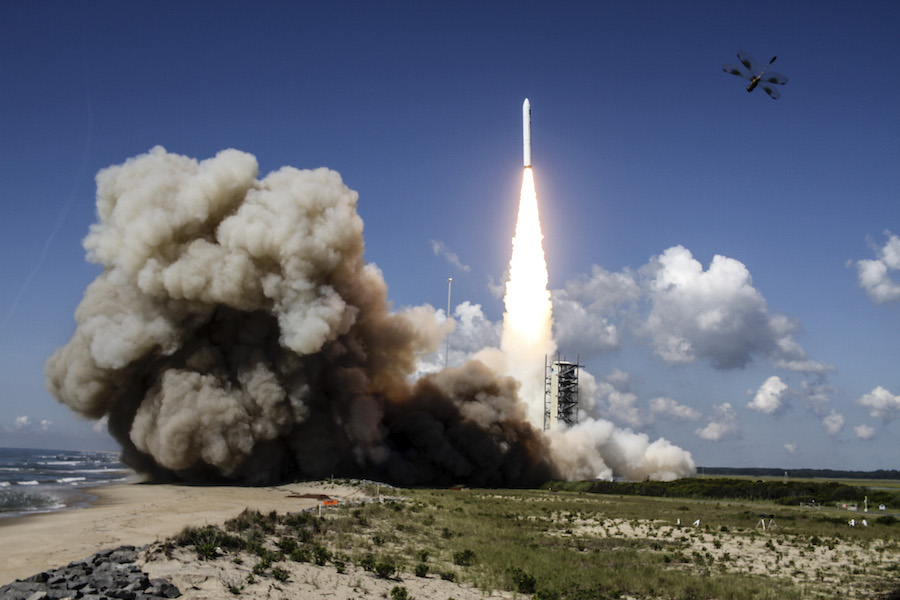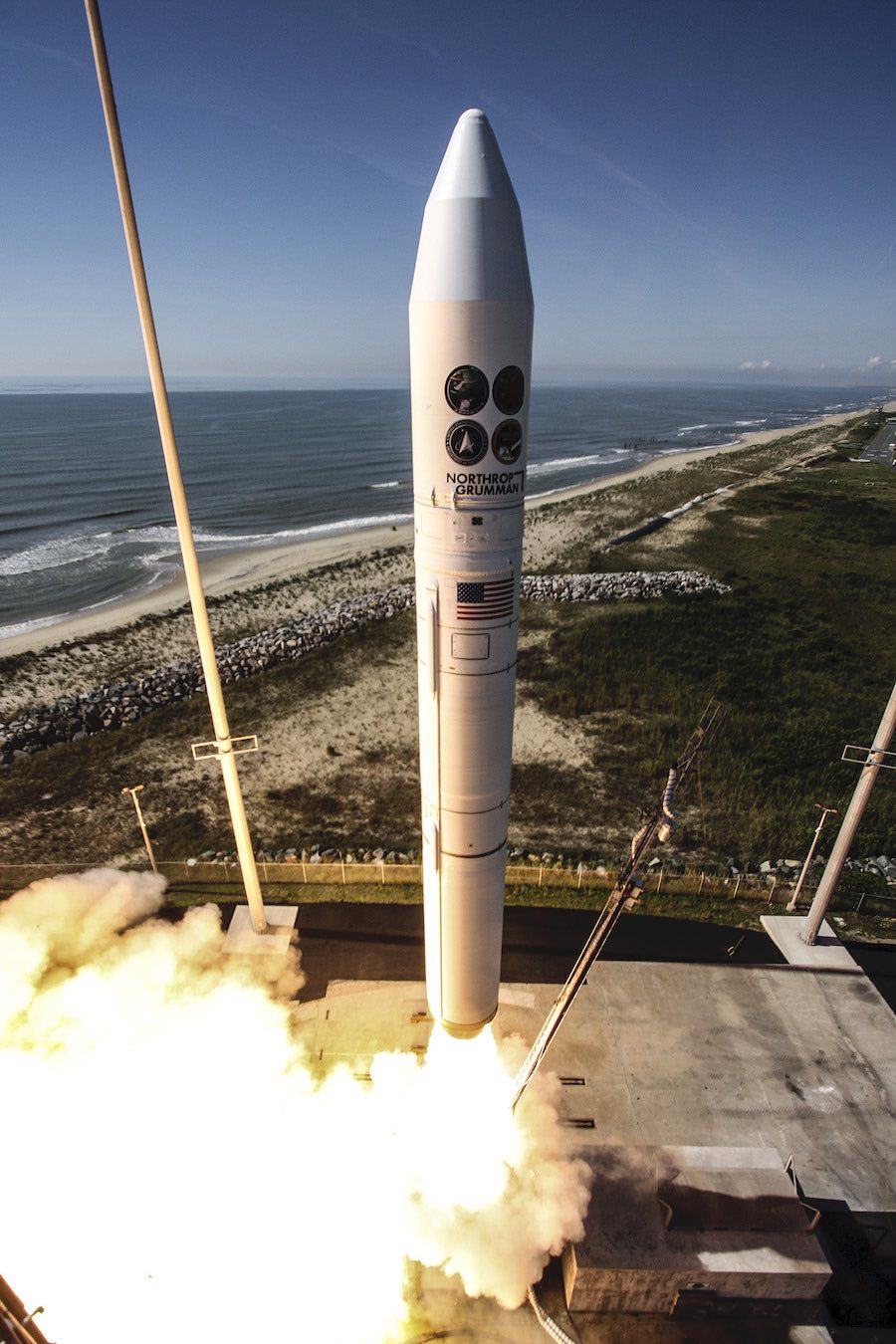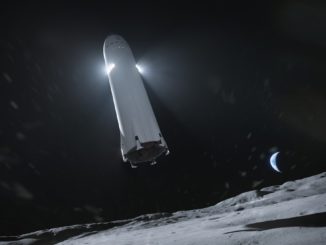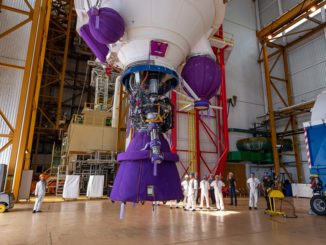
A solid-fueled Northrop Grumman Minotaur 4 rocket vaulted into orbit Wednesday from Virginia’s Eastern Shore and deployed four top secret spacecraft for the U.S. government’s spy satellite agency, extending the program’s success record ahead of three more Minotaur missions planned in 2021.
The 78-foot-tall (23.8-meter) launcher fired away from pad 0B at the Mid-Atlantic Regional Spaceport in Virginia at 9:46 a.m. EDT (1346 GMT) Wednesday after a 46-minute delay to wait for fishing boats to clear a hazard area near the launch site.
Riding a half-million pounds of thrust, the Minotaur 4 darted into a mostly sunny sky at breathtaking speed and broke the sound barrier just 17 seconds after liftoff.
Three solid-fueled rocket motors stockpiled from the U.S. Air Force’s retired Peacekeeper nuclear missile program powered the Minotaur 4 rocket into space. A commercial Orion 38 fourth stage motor then fired to inject the four National Reconnaissance Office payloads into orbit a few hundred miles above Earth.
A live video stream of the launch provided by NASA’s Wallops Flight Facility, which oversees the launch site, ended a few minutes after liftoff of the Minotaur 4 rocket at the request of the NRO. The rest of the flight occurred in a news blackout without live updates.
The National Reconnaissance Office confirmed the launch — designated NROL-129 — was a success later Wednesday morning.
“I could not be prouder to witness NRO’s first dedicated launch out of NASA’s Wallops Flight Facility in Virginia,” said Chris Scolese, director of the NRO. “NROL-129 represents a collaboration between the NRO and our industry partners to design, build, launch, and operate a system of satellites that will demonstrate revolutionary capabilities of value to the nation and our allies.”
The NRO did not disclose details about the design or purpose of the four NROL-129 payloads. The NRO is part of the U.S. government’s intelligence community, and owns a fleet of optical and radar surveillance satellites.
“Despite facing challenges in 2020, we found new and better ways to collaborate with our partners from a distance, relentlessly pursuing our mission and denying sanctuary to our adversaries,” Scolese said.
“I’m excited to add this new chapter to the NRO’s long history of developing, launching and operating sophisticated overhead intelligence systems in support of our nation’s security, and I look forward to a future with more opportunities for collaboration on the Virginia Space Coast,” he said.
The launch Wednesday marked the 27th flight of a Minotaur rocket since January 2000, and the first Minotaur satellite delivery mission in nearly three years. It was the seventh Minotaur launch from the Mid-Atlantic Regional Spaceport on Wallops Island, Virginia, and the first Minotaur to take off from there since 2013.
“This mission marks the 27th consecutive successful launch for the company’s Minotaur product line which celebrates its 20th anniversary this year,” said Kurt Eberly, director of launch vehicles at Northrop Grumman, in a statement. “Minotaur’s record of success along with its ability to responsively launch from multiple spaceports continues to be a valuable asset for our customers.”

Despite the low launch rate, Northrop Grumman says the Minotaur rocket family is well-suited for delivering U.S. military and NRO payloads into orbit.
“We’re really focused on making this the tried-and-true small-to-medium launch vehicle for the Air Force, and when they really need to launch when they want it, and it needs to be reliable, then we want to be that provider for the NRO and other DOD agencies,” Eberly said in a pre-launch interview with Spaceflight Now.
“I think what we offer is the ability to get to every orbit that they need from a variety of launch ranges,” Eberly said. “We’ve launched from Vandenberg, Cape Canaveral, here at Wallops … We’ve launched from Kodiak as well. So that just gives us the ability to fit different missions that the NRO and other DOD customers want to execute to different orbits.
“Different payloads need different processing facilities, and different availability from different ranges,” Eberly said. “So the ability to launch off of austere launch pads with these all-solid vehicles, it doesn’t take much. It’s really just a launch stool, and then a protected vault for our electrical ground support equipment. I think that’s pretty attractive to the Air Force.”
The government paid Northrop Grumman $38 million for the NROL-129 launch. The launch contract for the NROL-129 mission was awarded to Northrop Grumman in 2017 through the military’s Orbital/Suborbital Program-3 procurement vehicle.
The Peacekeeper rocket motors used on Wednesday’s launch were filled with pre-packed solid fuel between 1988 and 1990, then placed on alert in missile silos for 15 years until the military decommissioned the Peacekeeper in 2005, according to Col. Robert Bongiovi, director of the launch enterprise division at the Space and Missile Systems Center.
The Space Force maintains an “active aging surveillance program” to ensure decommissioned Peacekeeper and Minuteman missile motors can be made flightworthy in a short time when needed for a satellite launch. The missile motors are stored at Hill Air Force Base, Utah, and refurbished there before shipping out for launch preparations.
Ground teams at Wallops took precautions to reduce the risk of spreading COVID-19, and Northrop Grumman re-planned some operations associated with the NROL-129 mission, Eberly said.
Without a waiver, U.S. government policy requires the Minotaur rocket family only be used to launch military and intelligence-gathering satellites. The policy is intended to keep government-furnished equipment, such as the retired Peacekeeper stages, from competing with privately-developed rockets in the small satellite launch market.
The Minotaur 4 rocket can carry payloads of up to 3,814 pounds (1,730 kilograms) into low Earth orbit, according to Northrop Grumman. The smaller Minotaur 1 launcher is powered by decommissioned Minuteman missile stages, and is capable of injecting a payload of up to 1,278 pounds (580 kilograms) into low Earth orbit.
There are also heavier variants, such as the Minotaur 5 and 6, designed to launch payloads into higher orbits, or deploy larger satellites.

The Minotaur 4 and 5 rockets can carry heavier payloads than the commercial small satellite launchers developed by Rocket Lab, Virgin Orbit, Firefly Aerospace, Relativity Space, and numerous other firms fueled by venture capital financing.
Despite the Minotaur rocket’s low flight rate, Eberly said he thinks the program “fills a niche that is not really addressed very much for U.S. launchers.”
“Maybe (Europe’s) Vega is something similar in the international market, but the ability to launch two metric tons to low Earth orbit isn’t well-served, and I think a lot of space vehicles, and the kinds of new space vehicles that the NRO and others are producing, they just can’t always be served by the by the really small end of launch market,” Eberly said.
“So that’s where we can come in and offer a very dependable ride on a schedule, wherever they need us, and fill that bigger niche for payloads that just aren’t going to fit on a smaller vehicle, and they may not want to be on a rideshare, where you’re not able to drive the schedule, or if it’s a classified payload, you don’t want to be in a rideshare on a bigger vehicle,” he said.
“That’s where I think the dedicated launch aspect is very attracted to the NRO, where they can get just what they want. They can tailor the mission just the way they want, and then we can provide that service to them.”
The NRO has booked two more satellite launches on Northrop Grumman Minotaur rockets.
A classified payload is scheduled to take off on a Minotaur 1 rocket in the second quarter of 2021 on the NROL-111 mission. The NRO has also purchased another Minotaur 4 rocket for the launch of the NROL-174 mission in late 2021, Eberly said.
Both of those missions will launch from the Mid-Atlantic Regional Spaceport in Virginia, military officials said.
There’s also a mission assigned to a Minotaur 2 rocket — a suborbital Minotaur configuration — scheduled to fly from Vandenberg Air Force Base in California in late 2021, according to the Space and Missile Systems Center.
Email the author.
Follow Stephen Clark on Twitter: @StephenClark1.



